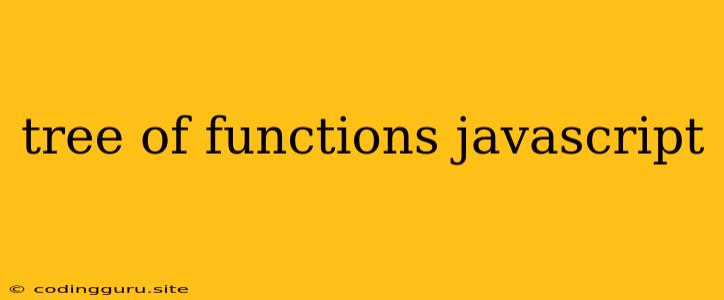Navigating the Forest: Understanding the "Tree of Functions" in JavaScript
JavaScript, being a dynamic and flexible language, often leads to complex code structures, particularly when dealing with nested functions and callbacks. This can feel like navigating a dense forest, where each function is a tree, and you're trying to understand the connections and dependencies between them. This metaphor is often referred to as the "tree of functions".
Understanding the "tree of functions" in JavaScript is crucial for managing code complexity, debugging efficiently, and writing maintainable code. Let's break down this concept and explore how it can help you become a more effective JavaScript developer.
What is a "Tree of Functions"?
Imagine a hierarchical structure, like a family tree, where each node represents a function. The topmost node is the initial function that starts the execution flow. Each branch represents a function call, and the leaves are the final functions that are executed.
Think of it this way:
- Root: The main function that starts the execution.
- Branches: Each function call creates a new branch in the tree.
- Leaves: The functions that are called at the end of the execution path, without further calls.
Here's a simple example:
function mainFunction() {
console.log("Starting the journey!");
functionA();
}
function functionA() {
console.log("Inside function A");
functionB();
}
function functionB() {
console.log("Inside function B");
functionC();
}
function functionC() {
console.log("Inside function C - The final destination!");
}
mainFunction(); // Starting the execution
In this code, mainFunction() is the root of the tree, and each subsequent function call (functionA(), functionB(), functionC()) creates a new branch. The final function functionC() represents a leaf, as it does not call any other functions.
Why Understand the "Tree of Functions"?
Grasping the "tree of functions" concept helps you:
- Debug Effectively: By visualizing the flow of execution, you can easily pinpoint where errors might occur and track the order of function calls.
- Write Maintainable Code: Understanding dependencies between functions allows you to refactor code more effectively, making it easier to understand and modify.
- Improve Code Performance: Analyzing the "tree of functions" can help you identify areas where optimization is needed by understanding the execution path and identifying potential bottlenecks.
Exploring Complex "Trees of Functions"
In real-world scenarios, the "tree of functions" can become very complex. You might have functions that call other functions recursively, or functions that are passed as arguments to other functions (callbacks).
Example with Recursion:
function factorial(n) {
if (n <= 1) {
return 1;
} else {
return n * factorial(n - 1);
}
}
console.log(factorial(5)); // Outputs 120
In this case, factorial() calls itself recursively until it reaches the base case (n <= 1). Each recursive call creates a new branch in the "tree of functions".
Example with Callbacks:
function fetchData(callback) {
// Simulate fetching data from a server
setTimeout(() => {
const data = "Data fetched!";
callback(data);
}, 1000);
}
fetchData(function(data) {
console.log("Data:", data);
});
Here, fetchData() takes a callback function as an argument. Once the data is fetched, it calls the callback function, effectively creating a new branch in the "tree of functions".
Tools for Understanding the "Tree of Functions"
Several tools can assist you in understanding the "tree of functions" in your JavaScript code:
- Debugging Tools: Browsers like Chrome and Firefox offer powerful debugging tools that allow you to step through your code, inspect variables, and trace function calls, providing a visual representation of the execution path.
- Visualization Tools: Some specialized tools can help you visualize the "tree of functions" graphically, providing a clear overview of the dependencies between functions and making it easier to identify potential issues.
Best Practices for Managing Complex "Trees of Functions"
- Modularity: Break down your code into smaller, more manageable functions.
- Comments: Add descriptive comments to explain the purpose of each function and its interactions with other functions.
- Use Meaningful Names: Choose clear and descriptive names for your functions to make your code self-documenting.
- Avoid Excessive Nesting: Try to keep your function nesting levels to a minimum for improved readability.
- Use Functional Programming Concepts: Techniques like pure functions, higher-order functions, and closures can help simplify your code and reduce the complexity of your "tree of functions".
Conclusion
Understanding the "tree of functions" in JavaScript is essential for writing well-structured, maintainable, and efficient code. By visualizing the execution flow, you gain insights into how your code functions, enabling you to debug effectively, identify potential performance bottlenecks, and write better JavaScript. Remember to utilize tools and best practices to manage the complexity of your "tree of functions" and ensure your code remains manageable and readable.
